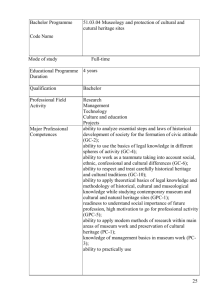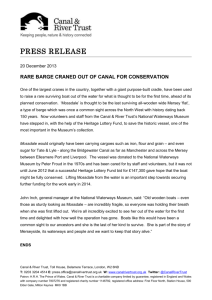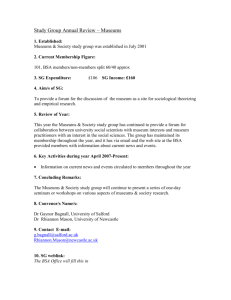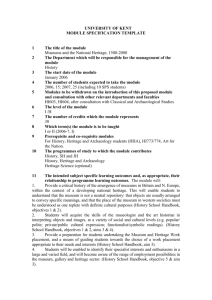Lifetimes and Museum Heritage Service
advertisement
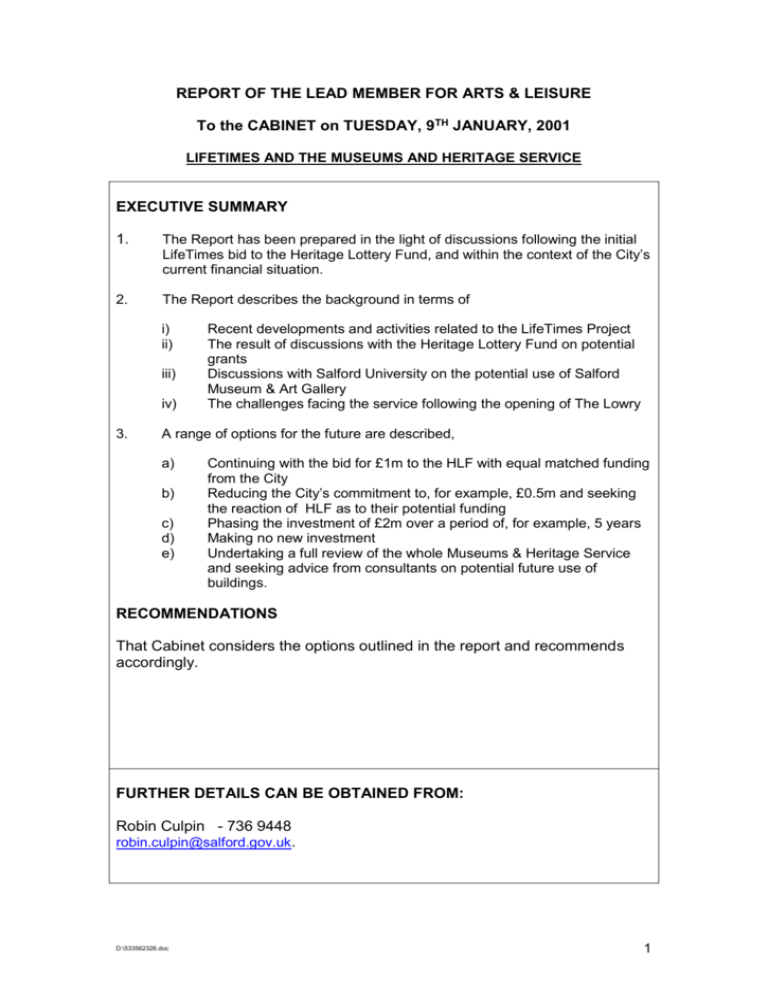
REPORT OF THE LEAD MEMBER FOR ARTS & LEISURE To the CABINET on TUESDAY, 9TH JANUARY, 2001 LIFETIMES AND THE MUSEUMS AND HERITAGE SERVICE EXECUTIVE SUMMARY 1. The Report has been prepared in the light of discussions following the initial LifeTimes bid to the Heritage Lottery Fund, and within the context of the City’s current financial situation. 2. The Report describes the background in terms of i) ii) iii) iv) 3. Recent developments and activities related to the LifeTimes Project The result of discussions with the Heritage Lottery Fund on potential grants Discussions with Salford University on the potential use of Salford Museum & Art Gallery The challenges facing the service following the opening of The Lowry A range of options for the future are described, a) b) c) d) e) Continuing with the bid for £1m to the HLF with equal matched funding from the City Reducing the City’s commitment to, for example, £0.5m and seeking the reaction of HLF as to their potential funding Phasing the investment of £2m over a period of, for example, 5 years Making no new investment Undertaking a full review of the whole Museums & Heritage Service and seeking advice from consultants on potential future use of buildings. RECOMMENDATIONS That Cabinet considers the options outlined in the report and recommends accordingly. FURTHER DETAILS CAN BE OBTAINED FROM: Robin Culpin - 736 9448 robin.culpin@salford.gov.uk. D:\533562326.doc 1 1. Introduction Before further expenditure is incurred and in the light of the City’s current financial situation there is a need to reassess the future of the LifeTimes Project This Report summarises developments and activity to date, and sets out a number of options for consideration. 2. Background 2.1 The LifeTimes Vision was developed several years ago when it was clear that the Lowry Collection would be leaving the Salford Museum and Art Gallery [SMAG]. LifeTimes creates a strategy for community heritage collections [museum, archive, local history], heritage visitor attractions and facilities [SMAG, Ordsall Hall, WCML, libraries etc.] and heritage initiatives [Steam, Coal and Canal, Worsley World Heritage Site] across the City to make the connections with Salford’s communities and key strategic issues such as: 2.2 Lifelong Learning Regeneration Schools/colleges Local photographic, art and history societies Local individuals and groups The Lottery Boards’ condition attached to the awards made to The Lowry states 6.1.18 that the Council has undertaken in a manner satisfactory to NHMF* that the development of the Lowry Centre and subsequent use of the Lowry Centre will not materially affect the amount of grant and other support which at present is made available for the Museum.” *NHMF = National Heritage Memorial Fund, now the Heritage Lottery Fund Supplemental Agreement dated 14th January 1997 relating to terms and conditions of grant for the Lowry Centre Trust on Pier 8, Salford Quays. “6. Conditions to disbursement of any grant 2.3 Following Committee approvals a bid to the Heritage Lottery Fund was made which involved the funding of the major physical refurbishment of Salford Museum & Art Gallery, the creation of better access and clearer visitor paths around the facility and the development of Lark Hill Place and a range of LifeTimes exhibition spaces. The bid proposed a project costing £4 million divided equally between the City and the HLF. 2.3.1 At a meeting, in June 2000, senior officers from the HLF fed back their advice on the bid, the main points of which were:i) D:\533562326.doc The HLF policy on funding levels had changed since the bid was submitted and they could not ensure a positive response from their Board if the bid for funds remained over £1 million. 2 ii) iii) iv) They were extremely enthusiastic about the LifeTimes concept and its ability to meet all the criteria on community participation, outreach, innovation and Lifelong Learning, which now applied. They advised that a bid asking for less than £1 million [50% funding] would not need to go to the National Board and would have a very high chance of success. They advised that any new bid at a lower level should take account of the need for the local authority to take on board more of the building maintenance costs and should concentrate on visitor attractions and community participation. The process of redrawing the bid at a level of under £1 million, matched by a similar amount by the City, has begun. 2.3.2 In October 2000 a meeting with the Pro Vice Chancellor and Deans from Salford University discussed the level of partnership between the University and LifeTimes and agreed that the University had no interest in purchasing or managing all or part of Salford Museum and Art Gallery; the University would be interested in use of spaces, on an occasional basis, for lectures, conferences and events; there were several ways that the development of LifeTimes could be mutually beneficial, particularly in terms of it being a showcase for the University’s Virtual Reality development and of the University providing assistance with Website and digitisation developments. 2.4 The evidence of success after LifeTimes’ first year involves local publishing, workshops, oral history, volunteer projects and donations of material. The LifeTimes Project has also received national recognition through the award of grants from the Wolfson Foundation [£34,000], New Opportunities Fund [£400,000+ in partnership with Trafford Libraries] and the DfEE [£25,000]. In addition LifeTimes has established credibility as a means of developing the role of heritage in community regeneration. 2.5 As anticipated, visitor numbers at SMAG have fallen since the Lowry Collection was transferred and income from the shop and from Lowry Copyright has, predictably, fallen. 2.6 Several vacancies have arisen within the Service and some structural adjustments need to made to the staffing of the service which can only be done sensibly when decisions are made regarding the extent and timing of investment in the LifeTimes Project – for example: - 2.7 A long term commitment to a Collections Officer is vital to maintain Museum Registration, which, in itself, is a compulsory factor in accessing Lottery and other grant aid The LifeTimes Research and Outreach Officers posts are required as part of the matched resourcing of the Wolfson [£34,000] and Digitisation [£400,000] Projects It was shown, during the negotiations relating to the future of the collection housed at the Lancashire Mining Museum and the City’s ability to provide an D:\533562326.doc 3 Archive Service, that Salford’s attitude to and management of its nationally and regionally recognised collections is of concern to many agencies outside the City. The DCMS, Re:source [the Museums, Libraries and Archives Council], the Public Record Office, the Museums Association, the North West Museums Service and others have all been in formal and informal contact over the last year in this respect. 2.8 Any decisions on the future of the Museums and Heritage Service/LifeTimes, therefore, need to be made in the context of national, regional and professional policy, for instance: Any closures or loss of collections will jeopardise the potential solution which has been negotiated relating to the Mining Collection Loss of registration [see 2.6 above] will jeopardise the City’s ability to access Heritage Lottery and Museum related grant aid. 3 Options for the Future 3.1 Option 1 – Continue with re-submission of Heritage Lottery Fund bid (£2m.) Requirements: 1. Expenditure of £20,000 in 2000/1 for bid preparations and £25,000 in 2001/2 for bid development 2. A firm commitment from the City Council to match-fund any grant from Heritage Lottery Fund (up to £1m) at the time of application 3. Dedicated long-term building work schedule using the building maintenance budget 4. Ongoing additional revenue budget of £150,000 per annum Pros: 1. 2. 3. 4. 5. 6. 7. 8. 9. Will deliver the LifeTimes vision, albeit at a modest level. will create new exhibitions, education/community resource, visitor facilities Meet The Lowry Lottery commitment to safeguard the future of Salford Museum and Art Gallery Safeguard, and make better use of, collections Provide opportunity to work in partnership with Salford University to showcase virtual technology The bid is highly-likely to be successful – introducing around £1m from the National Lottery Should provide the ‘product’ to stimulate private sector partnerships Would be one phase of work and open as a new visitor attraction Would fulfil the City’s promise to the Public Record Office to safeguard and develop access to our heritage archives. Cons: 1. However committed the City Council is to LifeTimes and the future of Salford Museum and Art Gallery, there are likely to be doubts about match-funding and HLF committing on-going revenue funding. 2. The necessary costs involved in preparing the new Stage 1 application and developing the Stage 2 bid is considerable (c. £45,000) and D:\533562326.doc 4 2. places much pressure on the over-subscribed Corporate Lottery Fund and could be difficult to justify on a ‘lost cause’. Compromises to reduce the overall costs means that the basement area remains undeveloped. [It is timely, therefore, that the City Council reviews this option which would maximise benefits but at a considerable investment. The near-certainty of a positive response from Heritage Lottery Fund adds to the pressure to make a considered decision. Without firm commitment on funding, this option would rapidly become unsustainable.] 3.2 Option 2 – Reduce the City’s capital finance commitment to, for example, £0.5m This option would provide for a reduced financial commitment by the City Council and should attract additional funding from Heritage Lottery Fund (though not on a guaranteed pound-for-pound basis). The project would, therefore, have to be delivered on a base budget of £500,000. Pros: 1. Would deliver some of the LifeTimes benefits 2. may be more achievable in terms of funding 3. would re-launch the museum to a certain extent Cons: 1. Would probably not stimulate private sector involvement 2. only part of the building (probably the ground floor) would be refurbished 3. the quality of the visitor attraction would be compromised 4. would leave a residue of unresolved issues 5. would require complete new process for application for funds from external agencies 6. May reduce the city’s ability to fulfil its obligation to the Public Record Office regarding the safety of and access to the City’s Archives. 3.3 Option 3 – Phased project based on the £2m proposal This option provides for the achievement of the ‘vision’ over a period of, for example, 5 years in perhaps 3 phases. Phase 1 might be the ground floor. Pros: 1. 2. 3. 4. The objectives of the LifeTimes Project are achieved removes pressure on allocating a major one-off capital spend the museum could stay open throughout can stimulate private sector involvement at an appropriate stage Cons. 1. Disruption over a long period of time 2. uncertainty over funding of phases 3. no guarantee that Heritage Lottery Fund will fund the project beyond Phase 1 D:\533562326.doc 5 3.4 Option 4 – Do nothing This option allows the City Council to delay or cancel any development proposals, accepting that current difficulties will continue. Pros. 1 2. 3. 4. no capital funding or match-funding requirements Salford Museum and Art Gallery survives for the immediate future proposals for development may be re-visited if finances improve other development opportunities may emerge Cons. 1. Continues the spiral of decline initiated by the development of The Lowry 2. Museum lacks focus and is difficult to market 3. Visitor attraction diminishes 4. Museum becomes unsustainable. 3.5 Option 5 – Undertake a full review of all the elements of the Museums and Heritage Service to determine how best it can meet the strategic objectives of Lifelong Learning and Access/Participation. This would involve, a) Commissioning a consultancy to consider the potential future use of Salford Museum and Art Gallery from a commercial perspective, exploring a wide range of possible uses for the building which may, or may not, include a museum and gallery function, and proposing options on the range of investment required, other uses, shared occupation or disposal b) Completion of the current study on the future of Ordsall Hall Museum, investigating options of possible partnerships, levels of investment and options for disposal. c) Investigating, in co-operation with the Public Record Office, how best to store and provide access to the large City Archive now within SMAG d) Investigating how best to store and provide access to the other nationally important collections within SMAG, OHM and the Working Class Movement Library e) Investigating how other satellite sites could best fulfil the objectives – WCML, Clifton House Farm, Worsley, the Quays, Steam, Coal and Canal f) Developing Outreach policies – to schools, communities, etc., the use of other sites [libraries, churches, community centres], the effectiveness of a LifeTimes Mobile. g) Working with the wider museums, heritage and cultural community [DCMS, North West Museums Service, Lottery Boards] to ensure their support for radical service development D:\533562326.doc 6 Pros 1. The development of a clear, 3 to 5-year plan for the development of LifeTimes would sustain and stimulate the pathway to change for the service, 2. The plan would provide a clear range of options involving potential efficiencies, potential capital receipts potential revenue savings and required investment [internal/external] 3. The consultancy would provide an independent view of the potential use of SMAG to meet the City Council's’ aspirations, it may offer innovative ideas and secure a viable and sustainable future for the building 4. The result would provide a strategy in which the DCMS and the wider museums & heritage community could see properly planned and coherent change leading to a ground breaking service; and the basis for consistent investment from lottery and other grant aid. Cons 1) The spiral of decline in the use of SMAG would continue during the life of the Review 2) The HLF and other external agencies, who are expecting a bid from Salford, will need to be convinced of the value of the Review. D:\533562326.doc 7
